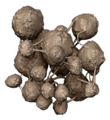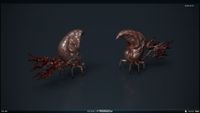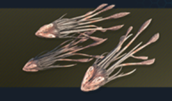Infection form
From Halopedia, the Halo wiki

Infection forms are a wide classification of various Flood forms, designed to be produced in vast numbers by the parasite for the task of converting other living creatures into combat forms, carrier forms, tools or simple food to fuel the endless growth of the infection.[1][2]
Overview[edit]
Infection forms serve as the primary vector of the spread of the Flood, and come in a variety of various forms to help achieve this goal across numerous mediums - working to crawl, fly, swim, dig, or climb their way toward their victims. They all share several key morphological traits, and are primarily used to forcibly enter and take over the bodies of both sapient and nonsapient living creatures for use as tools for further spread of the parasite. Each infection form has only the most limited intelligence, and seeks the nearest target out in overwhelming hordes. Once an infection form gains contact with victim, it is able to take over the victim's nervous system and gain access to their memories - sifting through their knowledge for information that might further help the spread of the Flood. This is accompanied by injecting the victim's body with Flood Super Cell deposits, beginning their conversion into a combat or carrier form.[1]
Life cycle of the infection[edit]
The infection form's life cycle begins with the most simple component of the Flood infestation - Flood spores. Although visibly distinct from their larger cousins, spores are classed under the infection form family and can take on a variety of appearances depending on their environment. When affixed to a suitable source of biomass, Flood spores will begin to transform the victim into a creche for growths of the Flood Super Cell (while kept alive) - with the end goal of ultimately turning the victim into egg-like incubators from which to grow larger infection forms such as the larger pod infector or seeder infector. Non-sapient creatures of corpses too mangled for useful use are turned into blisters and other forms of static growth to create more infection forms, while select victims are mutated into carrier forms - a mobile growth sac of infection forms.[1]
Types of infection form[edit]
- Flood spore: The smallest and most basic kind of infection form, spores may be released and lay dormant in an environment for centuries - waiting for a potential food source to arrive. Upon contact with a suitable organism, they begin to mutate it in such a way as for it to begin incubating the larger kinds of infection form.[1]
- Pod infector: Pod infectors are the most common type of infection form, and ubiquitous enough that they are often simply referred to as infection forms themselves.[1][3]
- Seeder infector: Seeders are lighter-than-air airborne infection forms created once a given hive reaches self-sufficiency.[1][4]
- Flood blister: Blisters are formed from the remains of infected animals or badly-damaged corpses unable to serve other functions. They act as incubation grounds for spores and infection forms, bursting and releasing their contents when they detect movement nearby.[1]
- Flood dispersal pod: Dispersal pods serve as living forms of drop pod - designed to act as containers to deploy other Flood forms onto a given planetary surface from a spacecraft in orbit.[1]
Sources[edit]
- ^ a b c d e f g h Halo Encyclopedia (2022 edition), page 406-407
- ^ Halo Wars 2, Phoenix Logs: Infection Forms
- ^ Halo Wars 2, Phoenix Logs: Pod Infectors
- ^ Halo Wars 2, Phoenix Logs: Seeder Infectors
| |||||||||||||||||||||||||||||||||




